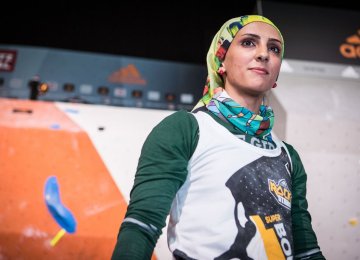Elnaz Rekabi, Iranian bouldering climber won the gold medal in the Bouldering category and bronze medal in Lead category at Wanxianshen Asia Cup in China, October 27-29.
Rekabi raced her rivals from China, Japan, Kazakhstan and Singapore in the finals of the games to grab two medals.
Khosro Hashemzadeh, Amir Nouri, Seyed Reza Chashi and Gholam Ali Baratzadeh were Iranian men competitors in the Lead and Bouldering categories who finished the tournament empty-handed.
Rekabi, 28, was the first Iranian female to compete full-time on the International Federation of Sport Climbing (IFSC) World Cup. As she received no support from the national federation, she had to finance her own career.
Recognizing bouldering talent in her native Zanjan Province, Rekabi became number one in the Bouldering and Lead National Championships in the past decade before struggling to break onto the global scene.
Now, besides emerging on the global climbing map she won second place at the Asian Championships in the Bouldering category, Iran 2013; third place at Asian Championships in the Lead category, India, 2014; and was first in the International Lead and Bouldering Master Cup in Iran.
Bouldering is a form of rock climbing that is performed on large boulders, small rock formations or artificial rock walls, without the use of ropes or harnesses.
While it can be done without any equipment whatsoever, most climbers use climbing shoes to help secure footholds, chalk to keep their hands dry and provide a firmer grip and bouldering mats to prevent injuries from falls.
Unlike free solo climbing, which is also performed without ropes, bouldering path is usually less than 6 meters tall. Artificial climbing walls allow boulderers to train indoors in areas without natural boulders. Bouldering competitions, which employ a variety of formats, take place in both indoor and outdoor settings.
Lead climbing is a climbing technique used to ascend a route. It is predominantly used in rock climbing and involves a lead climber attaching themselves to a length of dynamic (elastic) climbing rope and ascending a route while periodically attaching protection (quickdraws or traditional protection) to the face of the route and clipping into it.
The lead climber must have another person acting as a belayer. The belayer has multiple roles: holding the rope in the event of a fall, and paying out or taking up rope as the climber moves.






Add new comment
Read our comment policy before posting your viewpoints